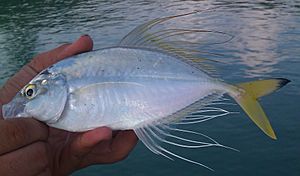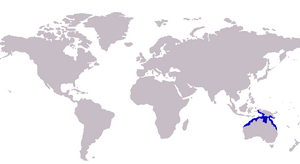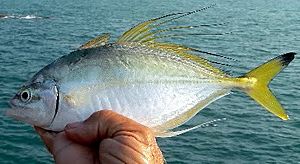Fringefin trevally facts for kids
Quick facts for kids Fringefin trevally |
|
|---|---|
 |
|
| Conservation status | |
| Scientific classification | |
 |
|
| Approximate range of the fringefin trevally | |
| Synonyms | |
|
Caranx radiatus Macleay, 1881 |
The fringefin trevally (Pantolabus radiatus) is a type of marine fish. People also call it the fringe-finned trevally, round-finned trevally, or reef herring. This fish belongs to the jack and horse mackerel family, known as Carangidae.
It's a fairly small fish. The fringefin trevally can grow up to 40 cm (about 16 inches) long. However, most of the time, they are found to be less than 25 cm (about 10 inches) long.
This fish has an oval-shaped body. Its fins are a bright orange-yellow color, which makes them easy to spot. It also has a black spot on its gill cover. The way its teeth are arranged helps scientists tell it apart from similar fish called scads. Male fringefin trevallies have special long dorsal and anal fins. These fins have long, flowing parts that look like trailing threads.
The fringefin trevally lives in the Indo-Pacific ocean. You can find it from northern Australia to Papua New Guinea and eastern Indonesia. It prefers coastal areas and estuaries (where rivers meet the sea). This fish moves around daily and with the seasons. The fringefin trevally is a predator. It eats small crustaceans, which are like tiny crabs or shrimp. Sometimes, these fish are caught by accident in nets used for prawns. Anglers (people who fish with a rod and line) also catch them sometimes.
Contents
What is a Fringefin Trevally?
The fringefin trevally is the only fish in its special group, called the monotypic genus Pantolabus. This group is part of the larger jack and horse mackerel family, Carangidae. This family has about 30 different groups of fish. The Carangidae family is part of an even bigger group called the order Carangiformes.
How Did the Fringefin Trevally Get Its Name?
The fringefin trevally was first officially described by a scientist in 1881. His name was William John Macleay, an Australian naturalist. He found the first specimen (example fish) in Rockingham Bay, Queensland, Australia. He named it Caranx radiatus. The word radiatus comes from Latin, meaning 'radiating'. This refers to the long, flowing parts of the fish's fins.
Later, other scientists gave the same fish different names, not knowing it had already been named. For example, in 1883, Macleay himself called it Caranx compressus. In 1903, an American fish expert named Samuel Garman called it Caranx parasitus. These later names are not used anymore because the first name given is always the official one.
The current group name, Pantolabus, came from another Australian fish expert, Gilbert Whitley. He thought Garman's fish belonged in its own group, similar to the Alepes group of scads. He named this new group Pantolabus. The name fringefin trevally is common because of the fish's long, fringe-like fins. Other names like "round-finned trevally" and "reef herring" are not used as often.
What Does a Fringefin Trevally Look Like?
The fringefin trevally is a small fish in the Carangidae family. It can grow up to 40 cm long, but most are smaller than 25 cm. Its body is oval-shaped, with the top and bottom curves looking similar.
One way to tell this fish apart from other scads (fish in the Alepes group) is by its teeth. It has a single row of slightly larger, cone-shaped teeth on its lower jaw. On its upper jaw, it has an outer row of cone-shaped teeth and inner rows of smaller, but sharp, pointed teeth. Like scads, it has a well-developed fatty eyelid on the back half of its eye.
The fringefin trevally has two dorsal fins (on its back). The first one has eight stiff spines. The second one has one spine and 20 to 26 soft rays. The anal fin (on its belly) has two separate spines, followed by 18 to 20 soft rays.
Male fringefin trevallies are special because all the soft rays in their dorsal and anal fins are very long. These long rays create distinctive filaments, with the longest ones at the front of the second dorsal fin. Both male and female fish have a scaly cover at the base of their second dorsal and anal fins.
The fish's lateral line (a sensory line along its side) has a curved part at the front. This curved part has 33 to 41 scales. The straight part of the lateral line has up to 9 scales and 38 to 49 bony plates called scutes. It also has 36 to 41 gill rakers (small projections on the gills) and 24 vertebrae (backbones).
What Colors Are They?
The fringefin trevally is olive-green to bluish-green on its upper body. Its underside is silvery-white. It has a large black spot on its gill cover, which is about the same size as its eye.
Its dorsal, anal, and caudal fins (tail fin) are all a bright orange-yellow color. The tail fin also has a black upper part. The pectoral fins (side fins) are pale orange or clear. The pelvic fins (bottom fins near the head) are white.
Where Do Fringefin Trevallies Live?
The fringefin trevally lives in a small part of the Indo-Pacific region. You can find them from northern Australia to Papua New Guinea and West Papua in Indonesia. In Australia, they are found from Port Hedland in Western Australia all the way to Gladstone in Queensland.
This fish mostly lives in coastal areas, close to shore. It rarely goes into waters deeper than 30 meters (about 100 feet). The fringefin trevally often swims into estuaries (river mouths). However, it usually stays in the lower parts of these environments, closer to the sea.
What Do Fringefin Trevallies Eat and How Are They Fished?
Not much is known about the fringefin trevally's life and habits. A few studies in northern Australia have looked at where they are found, how they move, and what habitats they prefer. These studies found that more fringefin trevallies were caught in trawl nets at night and during neap tides (when tides are not very strong).
In one study area in the Gulf of Carpentaria, these fish were present from January to August. After August, they moved out of that area. It seems that fringefin trevallies do not change their habitat as they get older. Fish of all ages can be found in estuaries, near the shore, and on the continental shelf (the shallow area of seabed near a continent). The fringefin trevally is a predator. It eats epibenthic crustaceans, which are small creatures that live on the seafloor.
The fringefin trevally is not a fish that people specifically try to catch for money. However, a small number of them are caught by accident in nets used for catching prawns in northern Australia. Sometimes, anglers catch them using bait or small lures. They are considered to be only a fair table fish (meaning they are okay to eat, but not the best).
Images for kids
See also
 In Spanish: Pantolabus radiatus para niños
In Spanish: Pantolabus radiatus para niños






